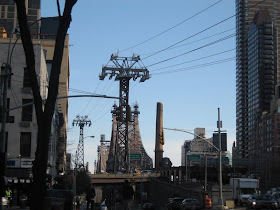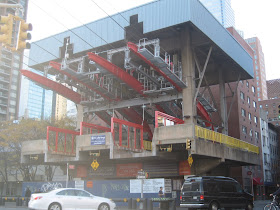
Whenever I see the Verrazano-Narrows Bridge I am so awestruck by its immense power that I nearly stop breathing. The bridge gives me the impression that it’s stuck in time; that it belongs somewhere back in the Jurassic period. Something about its lumbering presence makes me think of the Apatosaurus: the hulking, slow moving, graceful, gentle giant. When the bridge sways, I imagine that it does so with great poise, just as the prehistoric creature might. The bridge is the picture of refinement, strength and incomparable simplicity.

Approaching the bridge never fails to thrill. It has just two towers that ascend nearly 70 stories and a span of 4,260 feet. When coming at it from the Brooklyn side via the Gowanus Expressway, the cityscape on either side of the highway is bleak. Poorly maintained highrises and broken down storefronts do not prepare one for the majesty of the bridge as you approach. That may be what makes the Verrazano seem so grand. It rises out of a place that doesn’t seem noble enough to imagine it. But when leaving humble Staten Island, the quietness of the Verrazano feels like an extension of that borough’s sanguine tranquility.
There are many more vantage points from which to view the bridge. In Bay Ridge, where it lives on the Brooklyn side, one can stare up at it dreamily from the idyllic park just off Shore Road or directly under it from Fort Hamilton Park. From Staten Island, you can walk along the banks of the grassy Forth Worth Park and gaze up at it from there. What gives the bridge part of its silent power is that there are no buildings obstructing the panorama. There is only a vast sky. Viewing the bridge from any of these orientations gives the bridge the respect it deserves. The best way to look at the Verrazano bridge is from a perspective that allows your mind to wander from the past to the present to the future, from imagined pasts to imagined presents and imagined futures. This bridge asks for reverie.
But the Verrazano Bridge didn’t always engender such adoration. According to Gay Talese in his book,
The Bridge, for 20 years, the residents in Bay Ridge thought that all the talk about the bridge was just that; talk. They had heard that sort of talk before and expected the same inaction. Stretching back to 1888, there were plans for a railroad tunnel that would connect Brooklyn and Staten Island. But in 1957 the tone of the talk began to change because Robert Moses was becoming more determined. While the residents were under the assumption that the chatter would amount to nothing, engineers were quietly drawing up the plans. And in those plans was the large chunk of Brooklyn that would be sacrificed. The residents saw it as “an enormous sea monster that would soon rise out of the water and destroy eight hundred buildings and force 7,000 Bay Ridge people to move…”

The bridge was built in 5 years, between 1959 and 1964 and for 17 years, was the longest suspension bridge in the world. Because of the height of the towers and the distance between them, the curvature of the earth had to be taken into consideration. It gives the impression of the distance between the front and back legs of the dinosaur. I imagine our bridge getting up and walking around at night, bending its nose down to sniff the shores, nudging the drunks to make sure they don’t fall in the water, and protecting both Brooklyn and Staten Island and ultimately Manhattan from whatever might try to get pass through to the Hudson River from the Atlantic Ocean.
The Verrazano was designed by the engineer, Othmar H. Ammann, whose most significant achievement to date was the George Washington Bridge and who was considered the greatest bridge builder in the world. According to Talese, Ammann and his wife often gently bowed and saluted the George Washington when driving along the Hudson from upstate New York. “That Bridge is his firstborn, and it was a difficult birth,” his wife once explained. “He’ll always love it best.” From Ammann: “It’s as if you have a beautiful daughter and you are the father.”
Even though the Verrazano wasn’t finished until 1964, one has the feeling that it has always been the gatekeeper for the city, that it always acknowledged every passing ship, that it greeted every single person who came to New York by boat for the past 100 plus years. Looking east toward the Atlantic, you feel the thrill of potential travel. One can easily imagine taking the trip to Europe by ocean liner when that was the only available means of travel, slow passage, Adirondack chairs and blankets.
When I moved to New York, I lived in Bay Ridge, Brooklyn. I remember walking over to the park off Shore Road. Sure, I was isolated from New York City where I worked and longed to live, but there was something peaceful in this transition from Ohio girl to New York City girl. The tranquil feeling I got when looking up at that gargantuan bridge curbed any anxiety I might have had about living in New York. New friends always asked how was it going for me, assuming that I had to be going through some major emotional upheaval because I was from the Midwest. I simply didn’t notice a thing. The bridge was solitary, the park was always empty and I was pretty much alone. I liked it that way. Solitude was always precious to me and I saw the bridge as something also very much alone.

The bridge is painted a light blue-gray and there is next to no graffiti, which, even though there is no pedestrian walkway, is very odd. Those who tag structures usually see lack of access as the ultimate challenge. I drove on the upper level over to Staten Island and on the lower level on the way back to Brooklyn. I only is necessary to the language of a city, it made me happy to see that the Verrazano Bridge was unscathed. I would like to think that it is because the structure generates so much awe.
The only downside to crossing the bridge is the $13 toll onto Staten Island. You'd think that for that amount of money they would at least give you a sandwich.
















